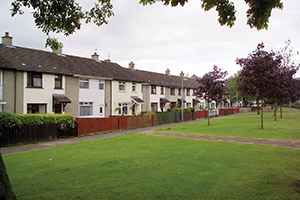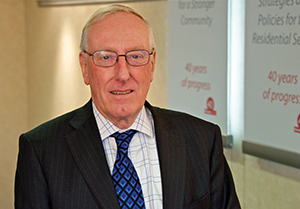Delivering a customer focused housing service
The Chairman of the Northern Ireland Housing Executive Donald Hoodless explains the benefits of putting customer needs at the heart of service delivery.
 One of the first impressions Donald Hoodless had of the Northern Ireland Housing Executive (NIHE) was of an organisation where “time had stood still.” The UK’s largest public landlord had not embraced change in years and had neglected to adopt new technology. This changed in 2014 as a process of reform designed to shape the services around the customers was adopted.
One of the first impressions Donald Hoodless had of the Northern Ireland Housing Executive (NIHE) was of an organisation where “time had stood still.” The UK’s largest public landlord had not embraced change in years and had neglected to adopt new technology. This changed in 2014 as a process of reform designed to shape the services around the customers was adopted.
In areas of the country where these reforms have already been rolled out efficiencies are clear to see. In South Down the number of days from first contact until the housing assessment is conducted and points are issued has been reduced from 21 days to 2.7 days. The number of days from initial contact to having a housing assessment completed was reduced from 11.5 to 1.5 days while the amount of time it takes the Belfast Housing Solutions and Support team to conduct their homeless assessment and issue both the decision letter and points letter has been reduced from 85.5 days to just 10.1 days. But just how has this improvement in customer service been achieved?
Thinking differently
While Hoodless is adamant that both service delivery and tenant satisfaction have been ‘very good‘ he was less than impressed with the design and processes used to achieve the end result. “We needed to change the way we delivered our services, it was very complex and very bureaucratic,” he says. “We had silos that occasionally talked to each other and that didn’t always work as effectively or as quickly as we would have liked and that often led to customers becoming confused about how they were being dealt with.”
 Conscious that the NIHE is more than just a landlord and aware of the fact that the services it offers are relied upon by the most vulnerable in society, Hoodless wants the Northern Ireland Housing Executive to be recognised as an organisation that is best in class and one that delivers a high level of customer satisfaction by 2017. The purpose of this reform process is to drive excellence while shaping the service around the customer.
Conscious that the NIHE is more than just a landlord and aware of the fact that the services it offers are relied upon by the most vulnerable in society, Hoodless wants the Northern Ireland Housing Executive to be recognised as an organisation that is best in class and one that delivers a high level of customer satisfaction by 2017. The purpose of this reform process is to drive excellence while shaping the service around the customer.
“Many organisations have a set of processes that measure their performance against those processes without considering the outcomes for the end user or customer. That is what this reform is trying to address and it is doing that by asking if for all the time and effort spent dealing with customer problems, have the services actually helped customers and is there a more efficient way to deliver these services?
“To achieve this excellence we needed to think differently, we needed to say ‘yes’ and realise we can manage it better. We have new operating models in place and when designing the service we made certain we had leaders in place able to oversee and give responsibility to staff. Ultimately it is the customer that matters and the big change that we have to embrace is adopting the technology that will enable us to embrace this change. We do need to work much harder at technology to support staff and allow them to run better services.”
Thinking differently about how to shape the service around the customer has resulted in the development of new ways of working. Housing customers now have one single point of contact making services easier to understand and communicate with. The housing solutions and support teams work with customers at the front end to provide a comprehensive list of housing options ensuring that the customer is fully informed throughout the process. In areas where this reform is yet to be implemented customers are asked to fill in a form and are placed on a waiting list to be contacted once a unit becomes available.
For tenants, Patch Managers are now their sole point of contact and can assist with any issues they have. Under the old system, Patch Managers were unaware of tenant rental issues as rent was dealt with by someone else in a different silo. Managers are now also in place to support staff in making the right decisions for their customers and as the system roles out across Northern Ireland investment in staff will be crucial to maintain these new found efficiencies.
Putting people first
Hoodless estimates that 400 staff will need to be recruited from within the organisation to fill the new roles and maintain current services. Putting the new structures, systems and support in place will be vital as staff will need support in these new roles and if the supporting systems are not there, the system will not work as effectively as it has in the pilot areas.
“Ultimately these changes allow us to have proper conversations with people,” states Hoodless. “We are trying to build a new way of working with customers to take a much more comprehensive approach rather than just looking at our services. It is all about supporting people to help themselves and we can see real benefits for our customers as a result of this.” While these reforms are showing encouraging signs of progress, at present only 10,000 tenants and 20 per cent of those waiting for a house are benefiting from these redesigned services. Hoodless is keen to continue at pace with the reform and expects to see the new services rolled out across Northern Ireland throughout the rest of this year.
“People have always responded very positively to the way we do things and we are moving quickly to come to a conclusion for our customers. This transformation has given us the opportunity to restore trust in the organisation and our reputation. By embracing these changes we are shaping our own future rather than having it shaped for us.” Hoodless concludes.





